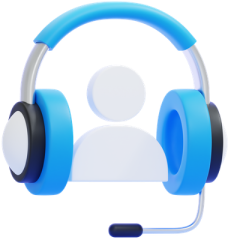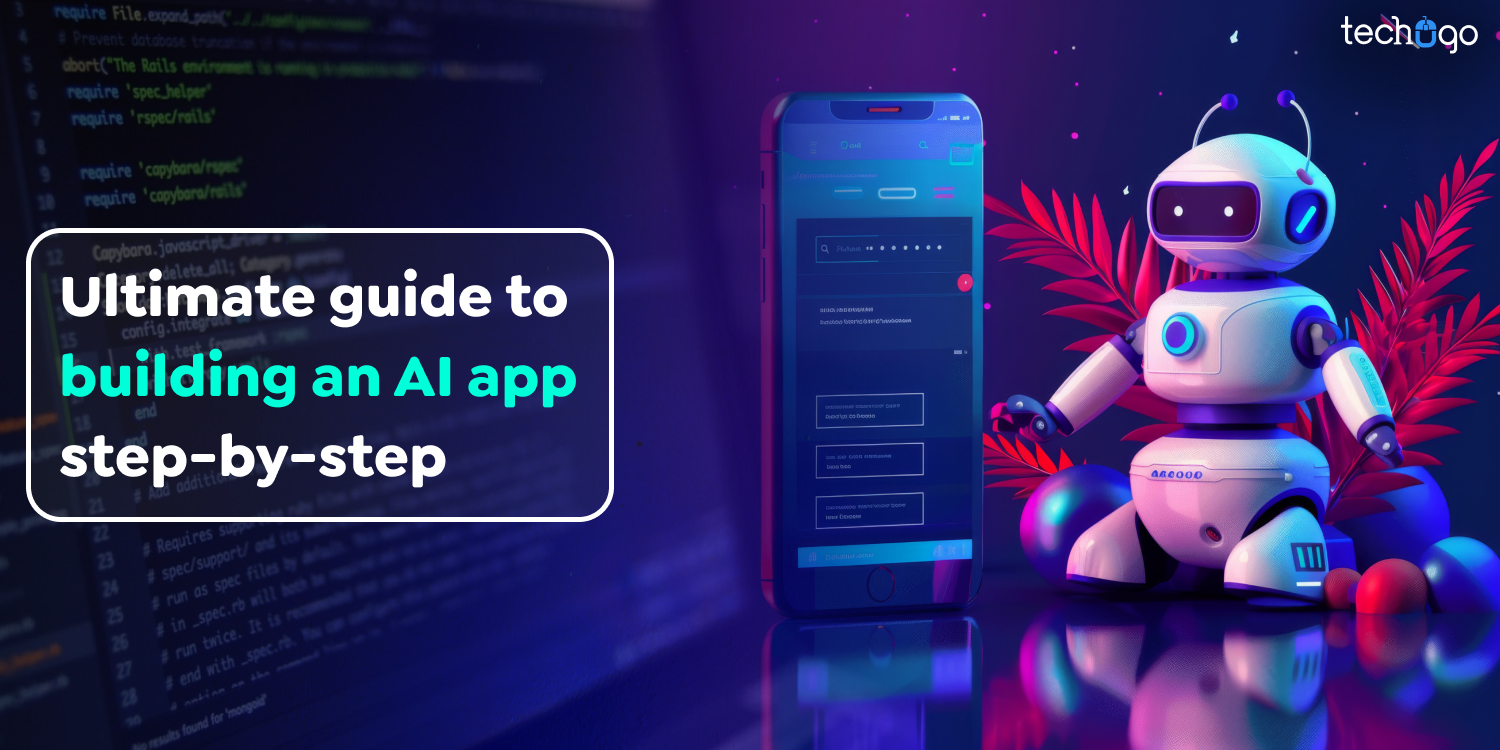16 Oct 2024
Updated on January 30th, 2025
The Complete Guide to Developing Clinical and Patient Decision Support Software
Matthew Connor

The pressure placed on medical professionals to enhance the quality of care while maximizing the efficiency of their operations is never more significant. Clinical decision support implementation is at the top of the challenge. It offers an opportunity to transform our work, but often by complexity. Imagine an integrated system with data-driven information that empowers your teams of clinicians to make well-informed, rapid decision-making. Imagine a world in which technology is supportive and anticipates the requirements of patients and providers.
Clinical and patient decision support software have been integral components in modern healthcare, changing how medical professionals make the right decisions and care for patients. The systems employ sophisticated algorithms and medical knowledge bases to allow clinicians to offer accurate, scientifically based information and suggestions.
In a time of rapidly growing medical information, clinical and patient decision support software is a vital aid to clinicians, assisting them through the maze of research and patient data. By integrating patient information with the relevant knowledge of medical professionals it assists healthcare providers with making informed choices in the moment of need. Clinical decision support systems function similarly to intelligent assistants for physicians.
The blog will provide every aspect, benefit, and cost of creating clinical decision-support software.
What Is Clinical Decision Support Software?
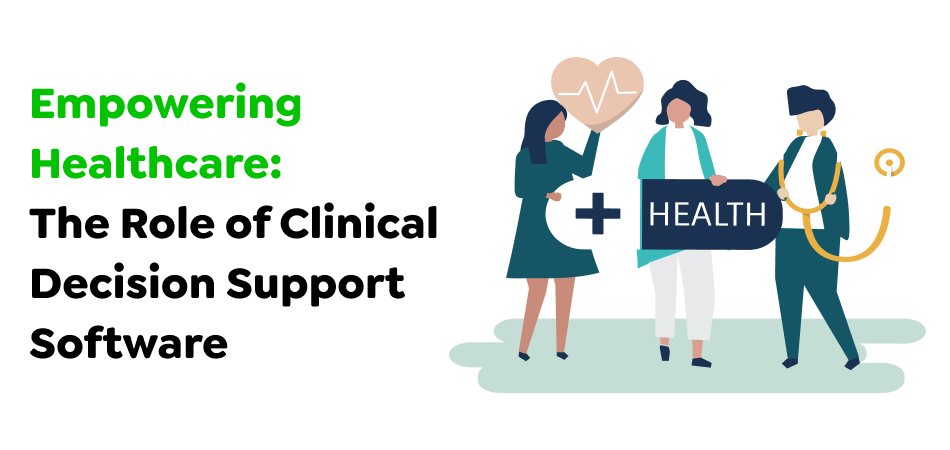
A clinical decision-support software utilizes knowledge, data, and patient information to assist physicians in making sound decisions. It integrates medical information with data on an individual’s health condition to offer information, advice, and essential information that aids the doctor in making choices. A custom clinical decision solution for software development aims to enhance healthcare by giving caregivers information and facts based on studies in the moment of healthcare.
The most crucial feature of CDSS is the ability to connect data from various sources, such as EHRs, medical documents, patient histories, and diagnostic test results. CDS systems can generate unique insights specific to each patient by analyzing and consolidating the data. This helps clinicians better diagnose patients, select the appropriate treatment, and predict potential problems.
Clinical decision-support software may be found in many types, from standalone software to integrated features in EHRs and clinical workflows. Some examples of CDS tools are medical guidelines, diagnostic decision assistance, medication alerts to allergic reactions or drug interactions, and predictive analytics that help identify at-risk patients.
Also Read : Renewable Energy Software: Transforming the Future of Sustainable Energy Practices
Benefits Of Clinical Decision Support Software

Clinical decision support software can offer a wealth of advantages to healthcare. This is an in-depth review of every.
1. Improved Patient Outcomes
According to an investigation, one of the main advantages of a decision-support system is its ability to improve patient outcomes. With assistance from the software, clinicians gain greater insight into patients’ circumstances, making better diagnoses and deciding on the most effective treatment strategies. Additionally, clinical decision-support software aids in managing treatment progress with alerts, improving the likelihood of successful treatment.
2. Improved Quality Of Care
CDS systems give guidelines and recommendations based on the data that help create care programs that are more effective and meet the requirements of every patient. Suppose you’re looking to convert an existing application into a health-related application. In that case, it is recommended to consult the development of healthcare apps by a company.
3. Enhanced Decision-Making Process
CDSS technology helps healthcare professionals make educated choices regarding patient care, with access to up-to-date and pertinent information. This means clinicians can access many more options for diagnosis, treatment, and uncommon cases within shorter time frames. Patients who have more complicated and frequent illnesses benefit from being more successful in their treatment and diagnosis than those without having a CDSS put in place.
4. Reduced Medical Errors
Another advantage of clinical decision-support software is its potential reduction of medical errors, such as misdiagnosis or incorrect treatments. Medical errors are an apprehensive problem within the healthcare industry, with about one in five patients experiencing them yearly and 50% resulting from inaccurate prescriptions.
In this regard, the importance of CDSS for healthcare providers is vital. Reduced medical errors mean better outcomes for patients and lesser burnout among doctors. Additionally, reducing medical errors results in fewer lawsuits, which means fewer costs and losses in the reputation of clinics.
5. Increased Efficiency In The Healthcare System
Clinical and patient decision support software also aids in increasing efficiency within the healthcare system. The solutions provide healthcare professionals with up-to-date medical information, including research and studies. So, CDSSs will help reduce the time and funds devoted to research, allowing health professionals to concentrate on caring for the patient.
6. Better Use Of Resources
Clinical and patient decision support software allows healthcare providers to allocate their resources better. It has been observed that following the introduction of CDSSs, doctors run at least 31.5% fewer unnecessary tests compared to before. This translates to significant cost savings. It allows physicians to shift money to other, better-performing areas while providing patients with higher-quality and cost-effective medical care.
Also Read : Transforming Operations: The Role of Oil and Gas Software Development
Types Of Clinical Decision Support Software
Clinical decision support software aims to provide healthcare professionals with real-time information and suggestions for improving patient healthcare.
-
Knowledge-Based CDSS
They rely on a base of medical protocols, guidelines, and expert information to offer guidelines and aid in making clinical decisions. These systems typically employ algorithms or specialist methods to analyze patient data and provide guidelines.
-
Non-Knowledge-Based CDSS
Contrary to knowledge-based systems and others that are not based on knowledge, CDSS uses machines or statistical models to analyze patient information and predict or offer decision aid. They typically employ algorithms trained using large data sets to find patterns and relationships within patient information.
-
Therapeutic CDSS
Therapeutic CDSS aids healthcare professionals in selecting the appropriate treatment option and establishing individualized treatment strategies for patients. The systems can recommend specific medication dosage regimens and treatment plans based on the patient’s characteristics, such as medical history and established guidelines.
-
Diagnostic CDSS
Diagnostic CDSS helps healthcare professionals diagnose illnesses or ailments by studying patients’ medical histories, patient information, symptoms, and test results. The systems can offer differential diagnoses, suggest additional diagnostic tests, or provide diagnostic support using established standards and guidelines.
-
Monitoring And Surveillance CDSS
CDSS monitors the patient’s data, such as vital signs, lab results, and physiological parameters, to detect changes in the patient’s state and determine the probability of adverse reactions. They also provide alarms and alerts to healthcare professionals to aid in early intervention and preventive treatment.
-
Workflow And Process CDSS
Process and workflow CDSS concentrates on enhancing procedures and workflows in the clinical field to increase efficiency, productivity, and healthcare quality. They can aid in scheduling appointments or medication reconciliation, treatment coordination, and documentation management.
Also Read : Building Information Modeling Software: A Game-Changer for Modern Architecture
Process Of Clinical Decision Support Software Development
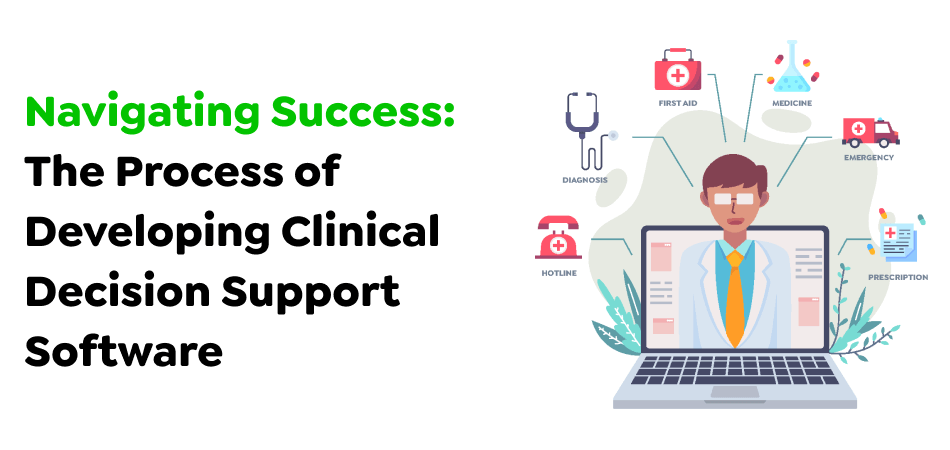
Clinical decision support software development needs a careful and systematic procedure to ensure that the program helps health professionals make sound decisions in their clinical practice. The key steps to create CDSS can be found below, as explained by our skilled creators:
1. Define Your Target Audience
Suppose you are beginning the development of software that supports clinical decision-making. In that case, it is essential to determine the people you’re creating it for and the kind of solution they’ll need. When you have the wants and demands in mind, the buyer and the vendor can envision how the software will be used. Software developers can create better products with solid relationships with customers who may purchase them.
2. Collect Information About Your Product Idea
Suppose you are planning to create clinical and patient decision support software. In that case, you must ensure you’ve got all the info you require to build a medical device, such as EMR software, before you even begin creating the software. This can assist you in determining what information is necessary for software development.
3. Design a Prototype
When developing software for clinical decision-making or an administration system for hospitals, it’s vital to have a working prototype that people can interact with. Wireframes that allow for user interaction with the software should be incorporated into your design. Prototyping is vital for various reasons when developing software for medical equipment. You could test your product this way before implementing it or seek assistance from a testing company.
So, you’ll be able to receive feedback to make sure you’re on the right course before investing lots of effort and expense in clinical decision support software development. If you alter your plan as you go and avoid any problems, you can prevent them and correct the issues before they go way too big.
4. Develop Your Final Prototype
Now is the time to create an official version of your clinical decision support software prototype when you’ve designed your project with prototyping technology and instruments. There is a need to learn the best way to develop software for the healthcare field and stay up to date with developments in the field of technology. Understanding the way your software is designed before it’s completed is crucial.
5. Coding
Suppose a custom software development company develops clinical decision support software from the beginning. In that case, they must invest time and effort, but they won’t need to spend hours writing codes for every item. Creating your product could take a little shorter time if you utilize software development kits or any other third-party software that can be integrated into the project.
Understanding your target audience’s needs and needs in the real world is essential for efficient CDSS development. Suppose you ask the client for their feedback. In that case, it is easy to select the most suitable programming language to meet their requirements and ensure they’re satisfied with the result once you’re done with Clinical Decision Support Software development.
6. Get Feedback
It’s not wise to release clinical decision support software before users can test and look at it. Therefore, it is essential to find reviews from those who have used your software and create an inventory of what can be improved.
Make sure your work is finished with the highest quality possible. Distribute the program, as well as any other updates and documents needed. If you have to release the software quickly, ensure people have enough time to use it and provide feedback.
Also Read : How Energy Trading Software Simplifies Risk Management and Compliance
How Much Does Clinical Decision Support Software Development Cost?
Ultimately, all it boils down to is cash. You’re sure you’d like to create the most effective medical decision-support software and keep costs minimal. However, the question is, “What will be the clinical decision to support software development cost?”. It’s somewhere between $10,000 and $30k or more, according to the requirements of your project.
However, consider developing an app for healthcare. In that case, the healthcare website development price will be identical to the previously mentioned. Additionally, the cost to create clinical decision support software will vary based on various aspects, such as the complexity of the software and functionality, the technology stack, and so on.
Low Complexity Software: $30K-$40K
Medium Complex Software: $45K-$65K
High-End Complexity Software: $68K-$150K
Also Read : The Complete Guide to POS Software Development: Types and Benefits
Tips To Choose Clinical Decision Support System Vendors
In selecting the best clinical choice support vendor, you must consider certain aspects to ensure you get the right tool for your needs. Below are the factors to examine before deciding on the CDSS vendor.
1. Your Organization’s Needs And Goals
Determining your business requirements is the first step when choosing the best CDSS provider. It is essential to decide on the data you’ll need access to, the type of decision-making tools you will require, and the degree of integration you’d like in your current clinical decision support software. This, of course, is also about evaluating your existing infrastructure and determining the capabilities of your system capable of, and what it is not working.
2. Assessing System Features And Capabilities
In addition, it’s essential to evaluate the capability of the vendor to offer the specific system you want. This involves looking at how the clinical decision-support software structure they have available can meet your requirements and objectives, as well as the convenience of using the system users and the degree of flexibility available for customization as the size of your company expands or shifts.
3. Evaluating Vendor’s Reputation and Experience
Selecting a healthcare app development company like Techugo with a solid reputation and a track record of building a CDSS is crucial. That means that you must look at their experience in the field and customer reviews on the examples they have of their CDSSs for clinical decision support and any awards or other recognition they’ve received.
4. Cost And Budget Considerations
Cost is an essential factor when choosing the right clinical decision-support software supplier. It is crucial to establish the budget you will need for CDSS design and implementation and then compare costs from several providers to identify which one has the highest cost-to-quality ratio for your business.
However, it might seem like an expensive expense at first. CDSS advantages include cost savings by automating administrative tasks and reducing medical mistakes. Therefore, in the end, incorporating CDSS into your organization’s infrastructure is a smart move.
5. User Feedback And Testimonials
Also, take into consideration customer feedback as well as testimonials. It is important to consider input from health professionals who have used the software and can provide information about the program’s efficiency and user-friendliness.
As the use of clinical decision-support software could significantly impact the workflow of your business, it is essential to make sure that the decision-support software doesn’t become complex and confusing. Without this, the result could be the opposite of what was intended. It could be a chance of causing more significant medical mistakes and diminishing doctors’ medical care.
Also Read : Driving the Future: A Comprehensive Guide to Automotive Software Development
Challenges Of Clinical Decision Support System
Clinical and patient decision support software can offer many advantages for the health system, some issues must be faced when implementing them. Most of them include interoperability, lack of standards, quality of data and precision, and resistance to change.
1. Interoperability
One of the most significant clinical decision-support software issues is interoperability with the current healthcare system. Interoperability is the capacity for different systems to connect and exchange information. It includes accessing and incorporating much information about patients from EHRs, laboratory instruments, and other sources without data loss.
It is also associated with the integration of CDSS in conjunction with existing technology. Interoperability is the term used to describe the integration of patient-doctor systems and other systems for clinical care. This means that the brand’s newly developed clinical decision-support software will be able to integrate into an organization’s current healthcare infrastructure without malfunctioning. Interoperability issues will hinder CDSS’s efficacy and make it more difficult to give complete and precise data to health providers.
2. Data Quality And Accuracy
Another obstacle to implementing clinical and patient decision support software is the need to guarantee the quality and precision of the massive datasets used by the system. Data that is inaccurate or out of date can result in incorrect decisions and misdiagnoses. Other extreme situations could negatively affect patient treatment. In addition, one challenge is ensuring that the data pertains to the individual’s health. A patient with a family history of heart disease might not require screening for breast cancer. CDSS should only provide relevant details for the patient.
It is, therefore, essential to ensure that your information is current, accurate, and up-to-date and accurately reflects the patient’s medical condition, test results, and physical and mental health history. Ultimately, quality and accuracy also require correctly incorporating scans and other test findings into their patient documents.
3. Lack Of Standardization
Another issue with developing clinical decision-support software is the requirement to improve industry standardization. Various user interfaces can cause confusion and difficulty in utilizing these systems efficiently. It can be challenging for healthcare professionals to evaluate and compare multiple options. This means they will require greater clarity and uniformity when they use CDSSs. In addition, the reliability and quality of the data provided by the system to healthcare professionals could be detrimental to their practice.
Finally, the absence of standardization could affect confidence in the data provided by CDSS, reducing the chance of healthcare facilities using CDSS properly. This ultimately prevents healthcare institutions and their patients from using CDSS advantages.
4. Resistance To Change
Reluctance to change is an atypical issue when adopting new technologies in healthcare. Health professionals may be concerned about its impact on their workflows and the risk of losing freedom of decision-making. The resistance could result in decreased adoption rates and adversely affect the efficiency of CDSS.
To address these issues, Healthcare organizations must engage their staff members in the development process and provide support and training to assist them in understanding how to benefit from and use the system productively for clinical decision-making. This includes providing practical training and help resources, such as instructions and user guides, and appointing dedicated support staff to answer any queries or issues.
It could also be beneficial to engage health professionals in the design and development of the CDSS to ensure that the system meets their particular needs. This will increase confidence in the changes and increase adoption, as health professionals are more likely to utilize a system they created and understood.
Also Read : How Offshore Software Development is Shaping Global Business Growth
Examples Of Clinical Decision Support Systems Application
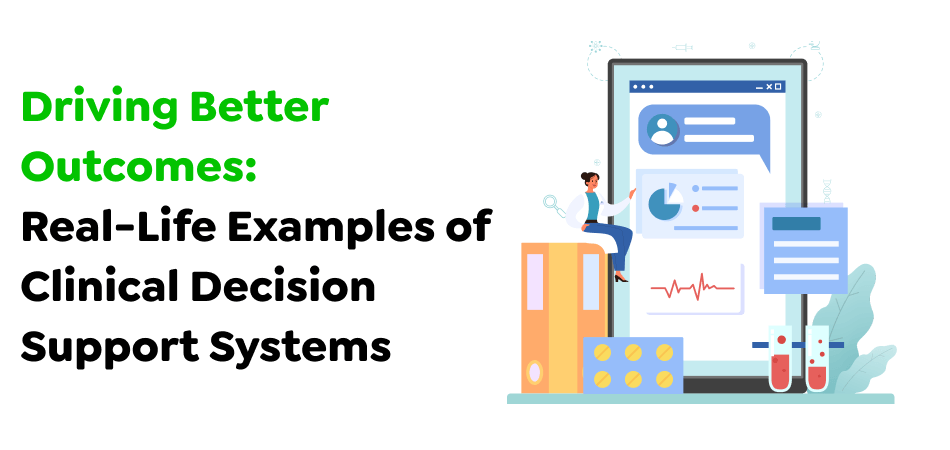
Clinical decision-support software can be used in many ways within the healthcare field. Here are some examples.
1. Diagnosis Support
Clinical decision-support software gives healthcare facilities access to medical data for diagnosing patients. Medical data include patient complaints, medical histories, pertinent tests, and findings from similar situations. When driven by AI and ML algorithms, medical professionals can make more accurate diagnoses quicker and more efficiently while deciding on what diagnosis to pursue.
2. Clinical Documentation
Clinical decision-support software can also improve the documentation of clinical care procedures. This includes electronic health records that allow medical professionals to access complete data about patients in real-time. CDSSs also provide tools to document patient information throughout visits, including the progress of notes, treatment plans, and results from diagnostic tests.
3. Treatment Planning And Drug Management
CDSS aids healthcare professionals in making the most appropriate treatment plan for their patients. This includes interactions with drugs, dosage suggestions, and contraindications. This tool can also help doctors identify the best medications to prescribe to patients based on their health history and current medications.
4. Patient Monitoring And Management
A different clinical decision-support software application monitors patients’ health and oversees their treatment, particularly those suffering from chronic conditions. This could include tracking essential health indicators, monitoring the patient’s progress, and delivering reminders to scheduled appointments and treatments. CDSSs may also issue notifications for serious health events or changes in a patient’s condition that require urgent intervention.
5. Clinical Guideline Implementation
In addition, clinical decision support software is utilized to establish guidelines for clinical practice in the healthcare environment. This means providing doctors access to current guidelines, the most effective healthcare techniques, and the instruments to monitor and track conformance to these recommendations. Compliance with clinical guideline guidelines will help improve the quality of medical care and patient outcomes while also reducing the risk of medical errors, unnecessary testing, and prescribing.
6. Management Of Medication
AI is a key element in helping healthcare professionals improve how they administer medications. When it analyzes patient information in depth, including health history, current medications, and pertinent clinical data, AI identifies potential drug interactions, adverse reactions, and medication mistakes.
Artificial intelligence-driven tools for decision-making use this information to create notifications and guidelines. It ensures that health professionals adhere to the safest prescribing guidelines and reduces the chance of triggering adverse drug reactions.
Also Read : Unlocking Success with Nearshore Agile Development: A Comprehensive Guide
Guidelines For Successful Implementation Of Clinical Decision-Support Software
Implementing clinical decision-support software successfully requires a careful plan, stakeholder involvement, and compliance with standard methods. These are the key points to think about:
1. Setting Clear Goals for CDSS Implementation
It is essential to define clearly the goals and objectives of the CDSS implementation. These include improving patient safety, increasing care quality, and improving healthcare delivery efficiency. The objectives should be aligned with your organization’s goals and strategic objectives, as well as the clinical requirements.
2. Collaborative CDSS Implementation for Stakeholder Success
The CDSS implementation process involves key stakeholders, such as healthcare professionals, IT employees, administrators, and patients. To ensure collaboration and support of the program, ask for input, discuss issues, and get the participation of all involved parties.
3. Optimizing Clinical Workflows for Seamless CDSS Integration
Examine existing clinical workflows and IT infrastructure to find ways to integrate CDSS seamlessly into your clinic. Ensure that CDSS is compatible with electronic medical records, integrated with other healthcare systems, and aligned with clinical workflows to reduce interruptions and maximize efficiency.
4. Choosing the Right Clinical Decision-Support Software
Choose clinical decision-support software technology that meets the company’s clinical, budgetary, and technical capabilities. Be aware of factors like capacity, interoperability flexibility, and the possibility of customization available on the CDSS platform to determine if that aligns with your organization’s requirements.
Create the clinical decision-support software in accordance with your company’s care protocols, guidelines, and preferred practices. Customize decision support rules or alerts to reflect local practices, patient groups, and care settings to ensure efficiency and relevance in care administration.
5. Empowering Healthcare Teams with CDSS Training and Resources
Offer comprehensive support and training to staff and healthcare providers regarding the use of clinical decision-support software. Hands-on training sessions, user guides, and web-based resources help users become familiar with CDSS capabilities, features, and the most effective ways of integrating into workflows for clinical use.
6. Evaluating the Impact and Efficiency of CDSS
Examine the impact and performance of CDSS implementation. Monitor its effect on clinical outcomes, patient safety, and workflow efficiency. Gather feedback from patients, analyze data on usage, and monitor key performance indicators.
7. Continuous Improvement and Optimization of CDSS
Review, refine, evaluate, and improve the CDSS based on feedback from users’ experiences and evolving clinical requirements. Introduce updates, improvements, and optimizations that improve accessibility, efficiency, and effectiveness over time. Develop a culture of constant enhancement and continuous learning so that the CDSS is in line with the company’s objectives and goals.
Also Read : Unlock the Future of Software Development: Key Trends in 2024
Conclusion
The clinical and patient decision support software can provide several benefits to healthcare providers, including improved patient outcomes, reduction in medical errors, and greater effectiveness. It provides quick, accurate, precise, and customized data that facilitates things for physicians, enhances patient results, and improves healthcare. However, there are difficulties associated with using the systems, such as compatibility, precision, and quality of the data in the absence of a standardization process and resistance to changes.
When we consider the future, it’s obvious that AI will play significant roles in determining how we approach clinical decision-making, providing healthcare professionals with the necessary tools and knowledge to offer personalized, evidence-based healthcare for patients. By fostering collaboration, creativity, and continuous dialogue between all stakeholders, we can tap the potential of AI to improve the quality of clinical decision-support software.
Get in touch with us today to learn how clinical and patient decision support software can elevate your healthcare services!
Get In touch
We are excited to here from you and let’s start something special Together. Call Us for any inquiry.
Write us
sales@techugo.caJust a call away
About you
